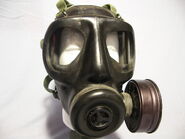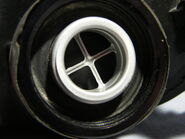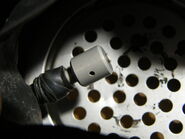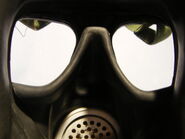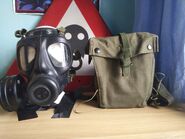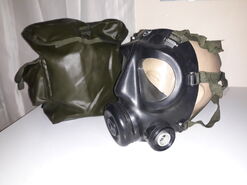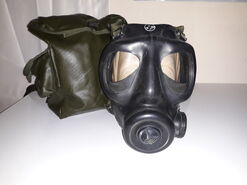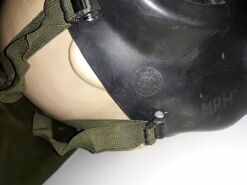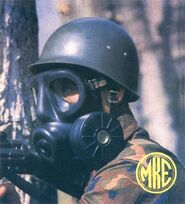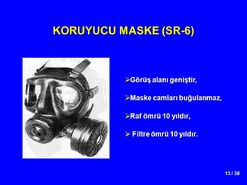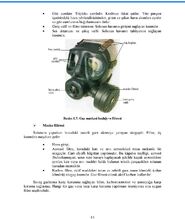No edit summary |
No edit summary |
||
| Line 35: | Line 35: | ||
Sometime around 1966, a prototype 'Extra-small' size was tested. |
Sometime around 1966, a prototype 'Extra-small' size was tested. |
||
| − | The S6 was issued in the 58 pattern haversack originally (1966 - c.1972) before being replaced by the Mk II haversack. The original 58 pattern haversack was made of a canvas cotton blend. This presented a huge decontamination issue - the haversack could potentially soak up chemicals and the small cotton fibres were thought to be capable of trapping deposits of deployed NBC weapons. The Mk II haversack was made of nylon coated in polyurethane which was thought to make decontamination much easier. |
+ | The S6 was issued in the 58 pattern haversack originally (1966 - c.1972) before being replaced by the Mk II haversack. The original 58 pattern haversack was made of a canvas cotton blend. This presented a huge decontamination issue - the haversack could potentially soak up chemicals and the small cotton fibres were thought to be capable of trapping deposits of deployed NBC weapons. The Mk II haversack was made of nylon coated in polyurethane which was thought to make decontamination much easier. |
| + | |||
| + | ==Filter== |
||
| + | The S6 respirator was equipped with several different canisters (see above infobox), but the two most commonplace canisters encountered are the No.1 Mk 1 (?) and the No.1 Mk 2 (?). Both canisters follow an archetypal construction of resin-wool and activated charcoal. One can differentiate between Mk 1 and Mk 2 by inspection of the canister bottom. The Mk 1 has a large central intake, whereas the Mk 2 has a series of slits arranged circularly, around the edge of the canister body. It has been suggested that the body of the canisters was changed due to the singular central intake on the Mk 1 being susceptible to clogging. |
||
| + | |||
| + | <gallery> |
||
DSCF0112.JPG|S6 with filter |
DSCF0112.JPG|S6 with filter |
||
DSCF0109.JPG|S6's intake valve |
DSCF0109.JPG|S6's intake valve |
||
Revision as of 08:41, 13 September 2020
The S6, or Service Respirator No. 6, officially designated Respirator, NBC S6, was developed in the 1950s by the Defence Science and Technology Laboratory, Porton Down and was manufactured by the Birmingham & Leyland Rubber Company. The S6 gained notoriety when seen being used by Britain’s Special Air Service (SAS) during the widely and thoroughly documented Iranian Embassy Siege on 5 May 1980.
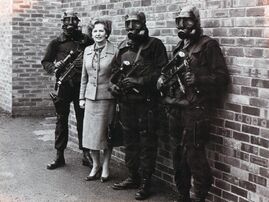
SAS personnel standing beside Margaret Thatcher while wearing S6 gas masks
Design
The features of the S6 include the very innovative inflatable air seal around the inside of the facepiece. It also had an early design of an oral-nasal cup that was built into the mould of the mask, not a separate piece extending from the interior of the facepiece to cover the nose and mouth. It features a six-point semi-elastic head harness with easily adjustable metal buckles.
A left-handed variant of the S6 was also used, with the filter being threaded onto the right-hand side of the mask. These particular models also have 'LH' (left-handed) imprinted on their rubber.
The mask provides an excellent field of vision using larger eyepieces in the shape of half-rounded rectangles.
Additionally, the S6 is made of soft black rubber. The mask uses a side-mounted filter to the left of the mask, making it much easier and more natural to shoulder a firearm for right-handed soldiers. It was very much liked by the British military for its comfort and very low breathing resistance.
Sometime around 1966, a prototype 'Extra-small' size was tested.
The S6 was issued in the 58 pattern haversack originally (1966 - c.1972) before being replaced by the Mk II haversack. The original 58 pattern haversack was made of a canvas cotton blend. This presented a huge decontamination issue - the haversack could potentially soak up chemicals and the small cotton fibres were thought to be capable of trapping deposits of deployed NBC weapons. The Mk II haversack was made of nylon coated in polyurethane which was thought to make decontamination much easier.
Filter
The S6 respirator was equipped with several different canisters (see above infobox), but the two most commonplace canisters encountered are the No.1 Mk 1 (?) and the No.1 Mk 2 (?). Both canisters follow an archetypal construction of resin-wool and activated charcoal. One can differentiate between Mk 1 and Mk 2 by inspection of the canister bottom. The Mk 1 has a large central intake, whereas the Mk 2 has a series of slits arranged circularly, around the edge of the canister body. It has been suggested that the body of the canisters was changed due to the singular central intake on the Mk 1 being susceptible to clogging.
Turkish Issued S6 Variant
At the end of 1970s Turkish Armed Forces demanded S6 masks for their CBRN response teams and Military from British Armed Forces. After several parties granted to MKEK, MKEK distributed S6 masks with the name of SR6 to TSK. Until the first period of 1990s TSK used this mask actively. Later on, MKEK developed their own S6 copies such as SR6M, SR10ST and SR10 Panaromic for military and law enforcement use throughout years. MKEK stamped these masks with 'MKEK' stamps instead of British Markings.

